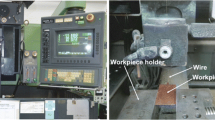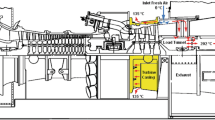Abstract
In the current study, experiments are performed on the aero-engine compressor blade model which is fastened to the disc using dovetail joint. Using the technique of photoelasticity, the highly stressed zone is found to be at the interface of the disc and the blade. Cyclic loading is then applied to the disc-blade assembly. Initial experimental observations showed formation of small cracks leading to crack growth and subsequent failure. In this region, a small crack is put and then the growth of crack during cyclic loading is studied till the failure of the specimen. The variation of stress intensity factor with respect to crack length and the number of cycles is evaluated for crack perpendicular to the contact length.
Access provided by Autonomous University of Puebla. Download conference paper PDF
Similar content being viewed by others
Keywords
Introduction
Aero-engine compressor blade and disc assemblies are subjected to high thermo-mechanical loads due to high speed rotation and the fluid flow over the blades. As indicated by Shi et al. [1], there are two major causes of failure due to fatigue viz., the action of centrifugal force causing a relative motion between the contact surfaces resulting in low cycle fatigue (LCF) and the high cycle fatigue (HCF) which is caused due to the vibrational loads. Along with the loading conditions, complexities like the contact geometry, surface treatments influence the failure mode and the amount of damage incurred at the blade-disk interface [2, 3]. Consideration of these factors is important while designing such components. It is challenging to simulate these conditions experimentally as the forces are continuously varying under real working conditions. However, representative experiments could still be conducted. The experimental fixture designed by Ruiz et al. [4] can be used to simulate both the centrifugal force and the remote disc loading. Rajasekaran and Nowell [5] also developed a similar biaxial fixture for simulating the combined effect of centrifugal force and blade vibrations. However, it is relatively expensive to perform tests using these fixtures. Hence, for simplicity the HCF and LCF experiments can be performed separately [1].
The present work is focused on the analysis of low cyclic fatigue in dovetail assemblies. A suitable dovetail specimen was selected and the fatigue experiments under cyclic loading were conducted. As shown by Durelli et al. [6], it is considered that along the thickness of the dovetail assembly, the stress variation is neglected and hence the dovetail stresses could be taken as a two dimensional problem. Using this assumption the experimental technique of two dimensional photoelasticity is used to get the information about the stress field in the presence of a crack. Using digital photoelasicity [7], the fringe data from the experimental images is obtained with the help of in-house developed software DigiTFP® [8] which is then used to find stress intensity factors (SIFs) using another in-house developed software PSIF. It employs an over-deterministic non-linear least squares approach to evaluate the stress field parameters.
Experimental Model Selection
A scaled down arrangement of blade and disc which is used in an aero-engine compressor is taken for the experiments. Epoxy sheet of 6 mm thickness is cast by mixing Araldite CY 230 epoxy resin and HY 951 hardener in the ratio of 10:1 by weight. The mixture is mixed carefully and then allowed to cure in the mould for 24 h at room temperature. The specimens of the required size as shown in Fig. 1 are then machined from this cast sheet using high speed router with precautions to avoid excessive heating and formation of residual stresses. The material stress fringe value for the epoxy specimens is found out using a circular disc of 50 mm diameter which comes out to be 11.90 N/mm/fringe for the wavelength 546.1 nm.
Stress Distribution at the Joint
In the aero-engine, the blades are subjected to various forces like centrifugal force, bending due to fluid flowing over the blade, unsteady centrifugal forces due to shaft vibrations along with thermal stresses and hence experiencing a cycle loading. Initially, the assembly is loaded under tensile load to evaluate the stress distribution at the joint which is shown in Fig. 2. The stress concentration region as shown in Fig. 2 is taken as the region of interest for further experiments.
Experiments Using Two Dimensional Photoelasticity
Once the region of interest is evaluated, an edge crack of 2.3 mm is cut on the blade by using a saw of 0.1 mm thickness. The crack orientation is kept perpendicular to the contact length. Then this dovetail assembly is fixed to the fatigue machine using a pin joint fixture at one end. Sufficient care is taken to avoid any misalignment between the applied force and the specimen axes as it can cause bending which can affect the test results. The dovetail assembly is then subjected to sinusoidal load variation with minimum to maximum force variation as 20–750 N with frequency of 2 Hz [9]. The images are recorded in circular polariscope arrangement using a high speed color camera Delsa Genie (CR-GC00-H6400, HM series) with a frame rate of 50 fps.
Stress Intensity Factor Evaluation Using Least Squares Analysis
The fracture parameters are calculated for the crack by processing the fringe data obtained from Twelve Fringe Photoelasicity (TFP) methodology by an over-deterministic non-linear least squares approach. Using the in-house developed software PSIF which uses a multi-parameter crack tip stress field equation proposed by Atluri and Kobayashi and corrected by Ramesh et al. [10], the SIFs are evaluated. For each case, it is ensured that the convergence error is less than 0.1 as below this value the data points match well with the theoretically generated image.
Result and Discusssion
When the cyclic loading is applied, the crack experiences a mixed mode loading and a very complex fringe field is obtained as shown in Fig. 3(a). To generate a well-matched theoretically reconstructed image, the solution requires eight parameters of mode I and eight parameters of mode II as given in Table 1 which are obtained using the multi-parameter stress field equation. Using these parameters, the theoretically reconstructed image is obtained as shown in the Fig. 3c along with the stress intensity factors for mode I and mode II. It is observed that even the very complex stress field is constructed well using the multi-parameter equation. Similarly, the SIF values for remaining crack lengths are also evaluated.
With the initial crack length of 2.3 mm, the variation of crack length with number of cycles is evaluated. The variation in the crack length for the last 500 cycles with interval of 60 cycles is given in Table 2. The specimen undergoes cyclic loading and failed at 3050th cycle at the crack length of 49.22 mm measured just before failure.
It is observed that the crack is increasing from 40.29 mm to 49.22 mm in 500 cycles. Considering initial time at 40.29 mm of crack length as zero, the specimen failed in next 109.22 s. Along with the crack length, the SIFs at different cycles were also evaluated using the multi-parameter stress field equations, for each 60 cycles interval staring from crack length of 41.27 mm. As observed by Muktai and Ramesh [11], the initial stages are having mode II dominance. Further observations from the current study showed that as the crack grows, mode I is becoming more dominant and the failure is occurred due to that.
In the current study, the fatigue analysis of only one orientation is completed. The effect of cracks on the blade with different orientations subjected to fatigue is currently under progress. This will further be used to predict the life of the blades under fatigue loading.
Conclusion
The aero-engine blade experiences the cyclic loading due to the various forces. The crack perpendicular to contact length is put and the variation of crack length is found following a linear trend with the number of cycles. It is also concluded from the observations that failure is occurred due to dominance of the mode I. Also, it is found that the computerized fatigue machine is synchronized with the high speed color camera and the selected frame rate of 50 fps is sufficient enough to capture the crack propagation. Hence this procedure is standardized will be used for further experimentations.
References
L. Shi, D.-s. Wei, Y.-r. Wang, A.-m. Tian, D. Li, An investigation of fretting fatigue in a circular arc dovetail assembly. Int. J. Fatigue 82, 226–237 (2016)
D.S. Wei, S.H. Yuan, Y.R. Wang, Failure analysis of dovetail assemblies under fretting load. Eng. Fail. Anal. 26, 381–396 (2012)
P.J. Golden, A. Hutson, V. Sundaram, et al., Effect of surface treatments on fretting fatigue of Ti–6Al–4V. Int. J. Fatigue 29, 1302–1310 (2007)
C. Ruiz, P.H.B. Boddington, K.C. Chen, An investigation of fatigue and fretting in a dovetail joint. Exp. Mech. 24, 208–217 (1984)
R. Rajasekaran, D. Nowell, Fretting fatigue in dovetail roots: experiment and analysis. Tribol. Int. 39, 1277–1285 (2006)
A.J. Durelli, J.W. Dally, W.F. Riley, Stress and strength studies on turbine blade attachment. SESA Proc XVI(1), 171–186 (1957)
K. Ramesh, Digital Photoelasticity-Advanced Techniques and Applications (Springer, Berlin, 2000)
K. Ramesh, DigiTFP® Digital Twelve Fringe Photoelasticity (Digital Photomechanics Lab, IIT Madras, 2017)
C. Ruiz, D. Novelli, Designing against fretting fatigue in aeroengines. ESIS 26, 73–95 (2000)
K. Ramesh, S. Gupta, A.A. Kelkar, Evaluation of stress field parameters in fracture mechanics by photoelasicity-revisited. Eng. Fract. Mech. 56(1), 25–45 (1997)
M. Thomre, K. Ramesh, Evaluation of Fracture Parameters of Cracks in Compressor Blade Root Using Digital Photoelasticity, in Proceedings of 4th International Conference on Reliability, Safety and Hazard, (2019)
Author information
Authors and Affiliations
Editor information
Editors and Affiliations
Rights and permissions
Copyright information
© 2020 Society for Experimental Mechanics, Inc.
About this paper
Cite this paper
Thomre, M., Ramesh, K. (2020). Analysis of Crack Growth in Compressor Blade Root Subjected to Fatigue. In: Silberstein, M., Amirkhizi, A., Shuman, X., Beese, A., Berke, R., Pataky, G. (eds) Challenges in Mechanics of Time Dependent Materials, Fracture, Fatigue, Failure and Damage Evolution, Volume 2. Conference Proceedings of the Society for Experimental Mechanics Series. Springer, Cham. https://doi.org/10.1007/978-3-030-29986-6_17
Download citation
DOI: https://doi.org/10.1007/978-3-030-29986-6_17
Published:
Publisher Name: Springer, Cham
Print ISBN: 978-3-030-29985-9
Online ISBN: 978-3-030-29986-6
eBook Packages: EngineeringEngineering (R0)







